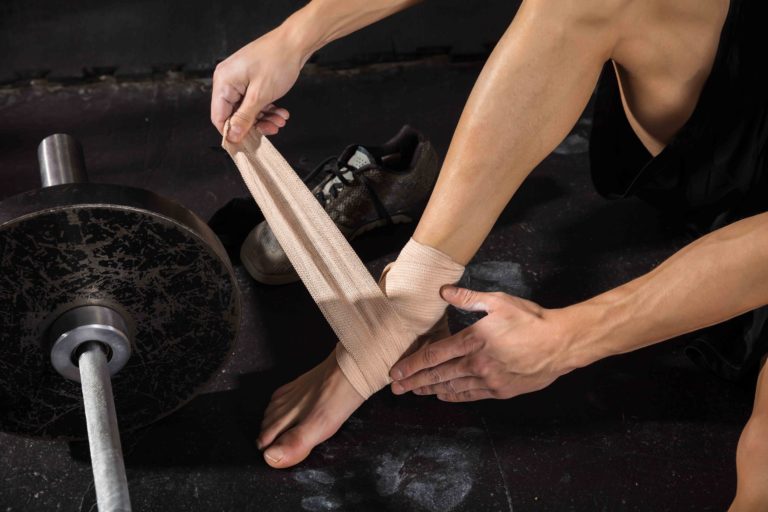Healing After Injury

This guide is designed as an introduction to the phases, stages, and progression of healing after injury or trauma.
The time frames listed here apply to the average individual. Therefore, it may differ for your particular case. General health, activity level, and the severity of the injury all influence your rate of healing.
For instance, healing favors those individuals of younger age, better physical shape, and/or individuals without co-morbidities or other medical conditions. On the other hand, healing is impaired in those individuals of older age, poor physical shape and body composition, those that are smokers, and/or those that have additional medical conditions such as high blood pressure, high cholesterol, and diabetes.
Secondly, a lower grade injury will likely heal faster than a higher grade injury. If you have sustained an injury, please be sure to consult with a licensed healthcare provider that can help individualize your rehabilitation program.
If surgery was performed, the surgeon will be able to provide more specific information and details regarding expected time frames for healing and return to activity. Make sure to follow your surgeon’s instructions carefully.
Phase 1: Inflammatory (Acute)
How do I know if I’m in the Inflammatory phase of healing?
The Inflammatory phase begins directly after an injury or trauma, and is often accompanied by constant pain and swelling.
Please keep in mind that this first stage of healing is not always present with all painful conditions. For example, if the injury was due to chronic overuse and a traumatic event did not occur, then appropriate healing may not include the acute Inflammatory phase. Therefore, you may potentially begin in phase 2: Proliferation.
The typical signs and symptoms that accompany the Inflammatory phase include:
- Increased pain (which is often constant)
- Increased swelling
- Increased redness/bruising/discoloration
- Increased heat surrounding the injured area
- Muscle spasm
- Reduced motion
How long should the inflammatory phase last?
It may last from a few hours to a few days, with the most common time-frame being 2-4 days as long as the appropriate healing conditions are provided.
What’s happening during the inflammatory phase?
The purpose of the inflammatory phase is to protect the injured area from further damage. The initial injury may have resulted in various amounts of tearing within the surrounding blood vessels. This tearing is often accompanied by internal bleeding, which is the most common reason to observe bruising and swelling directly after the injury.
Upon injury or trauma, the body will immediately initiate all necessary actions and procedures to protect the injured or damaged tissue. It does this by purposely increasing pain and initiating swelling.
Pain is deliberately increased in order to alert you that something has happened and you must be cautious.
Swelling, or inflammation, is deliberately initiated in order to carry beneficial cells and chemicals to the injured area and begin the process of repairing the damaged tissue. This process is absolutely vital for healing, so please do not fear inflammation! It is the first sign of your body attempting to fix a problem.
What’s the best treatment?
Pain during the Inflammatory phase is most often considered “chemical pain.” “Chemical” refers to the natural chemicals or substances your body releases to begin the recovery process.
You will likely be experiencing constant or almost-constant pain within this phase of healing. That is because a significant amount of your pain is caused by the inflammatory chemicals, and these chemicals are hard at work throughout the acute Inflammatory phase in order to help you heal.
Therefore, treatment will aim to manage the overall chemical process of swelling and inflammation by utilizing the principles of “PRICE.”
(P) Protected Motion
Perform safe and pain free movements, making sure to limit any activity that may further stress the injured area. After all, we are aiming to protect from further damage. Please consult with a licensed healthcare provider to help determine which movements are safe and which are not.
(R) Rest
Make sure to allow for sufficient rest of the injured area. But keep in mind that some activity may be recommended as described in “protected motion.”
(I) Ice
Ice is the most widely known and used treatment for acute injuries. However you may be shocked to hear that there is very little evidence of ice decreasing inflammation.
Nonetheless, ice is recommended after acute injury or trauma due to its ability to decrease pain, as well as protect from additional damage. Ice protects from additional damage by constricting blood vessels which may result in a reduction of blood loss from internal bleeding.
Heat on the other hand may actually dilate your blood vessels, and therefore increase internal bleeding due to the increased blood flow.
(C) Compression
Compression may be beneficial in the inflammatory phase of healing due to its ability to help manage swelling and inflammation. In addition, compression also assists with vasoconstriction (blood vessel constriction) and may therefore prevent further internal bleeding.
(E) Elevation
Elevation provides assistance in the Inflammatory phase of healing by promoting drainage of the fluid away from the affected region and back towards the heart.
Phase 2: Proliferation (Sub-Acute)
How do I know if I’m in the Proliferation phase of healing?
The Proliferation phase follows directly after the Inflammatory phase.
The healing chemicals which caused constant pain during the Inflammatory phase are now beginning to dwindle down as you enter the Proliferation phase. You will therefore begin to notice:
- A steady reduction in inflammation and discoloration.
- Pain that is no longer constant.
- Pain that is only present during certain movements or activities that specifically stress the injured area.
How long should the Proliferation phase last?
The Proliferation phase may last a few days to a few weeks. The most common time-frame for the proliferation phase is 3-6 weeks depending on the severity of the injury.
What’s happening during the Proliferation phase?
The purpose of the Proliferation phase is to repair the injured structures.
There should be a noticeable reduction in swelling at this stage. Keep in mind however that mild swelling may still be present because certain chemical processes are still helping to repair the injured area.
New soft tissue is beginning to form. During this process, scar tissue is forming, maturing, and strengthening. Keep in mind that scar tissue formation is a beneficial and normal part of healing, as it helps to reduce the need to actively protect the injury. Please understand that scar tissue only becomes problematic when it is created at excessive amounts.
What’s the best treatment?
Goal 1:
Improve the mobility, strength, and movement mechanics of the surrounding body regions, joints, and muscles in a manner that reduces excessive stress onto the injured area. This will allow for appropriate healing and recovery.
Goal 2:
Introduce exercises and activities that very gently stress the injured area. It is normal and not harmful to reproduce your pain while performing activities that gently stress the injured area during the Proliferation phase. However take note that there must not be any lasting or lingering pain afterwards.
Self-assess your pain 2 hours, 12 hours, and 24 hours after the symptom-reproducing activity. Lingering symptoms should not exist during those time points. If lingering pain does result, than the stress was too great; but not necessarily damaging so please do not be frightened. It would be appropriate to return to activities performed in the acute Inflammatory phase until these increased lingering symptoms subside.
Phase 3: Remodeling (Late Sub-Acute/Early Chronic)
How do I know if I’m in the Remodeling phase of healing?
The Remodeling phase follows directly after the Proliferation phase.
Minimal symptoms are experienced with daily activity during the Remodeling phase of healing. You will however notice that you have not yet regained full strength and/or motion. In addition, mild discomfort may be present when the injured tissue is stressed; however there is commonly no aggravation or worsening of symptoms with this stress.
How long should the Remodeling phase last?
The Remodeling phase may last a few weeks to a few months. The most common time-frame for the Remodeling phase is 6 weeks – 3 months depending on the severity of the injury. It is not uncommon to undergo remodeling for 6 months with certain conditions.
What’s happening during the Remodeling phase?
Although the Proliferation phase is complete, the affected area is still not strong or mobile enough to cope with increasing physical demands.
The purpose of the Remodeling phase is to strengthen and support the healing tissue until it is ready to meet the demands of normal exercise or physical function.
What’s the best treatment?
Treatment during the Remodeling phase is focused on improving strength and mobility of the affected region. In addition, a gradual return to previous activity will be initiated during this phase.
TAKE ACTION!
- If you have experienced injury or trauma, be sure to consult with a licensed healthcare provider specializing in this field in order to receive a definitive diagnosis rather than attempting to “guess and test.” The longer you wait to begin appropriate treatment, the longer your overall recovery will last.
- Discuss this healing process with your healthcare provider in order to determine the ideal approach to recovery within each stage of healing.
- If you are within the Inflammatory phase of healing, focus your efforts on the "PRICE" principles. Avoid applying heat as well as strengthening and stretching the injured area, as they may all prolong healing and potentially increase internal bleeding.
- If you are within the Proliferation phase of healing, focus your efforts on: 1) Improving mobility, strength, and movement mechanics of the SURROUNDING (non-injured) joints and muscles so that they may help take pressure and stress off of the injury. 2) Gradually introduce exercises and activities that very gently stress the injured area in ways that do not result in lingering pain.
- If you are within the Remodeling phase of healing, focus your efforts on improving mobility, strength, and movement mechanics of the previously injured area and structures.
Summary
After experiencing an injury or trauma, your body will undergo a healing process consisting of the Inflammatory phase, Proliferation phase, and Remodeling phase. Do not fear pain or swelling, but rather understand WHY it is occurring, and take appropriate actions to allow for recovery. Always remember… your body is designed to heal as long as you provide it the opportunity and conditions to do so!

Dr. Eugene Ketselman PT, DPT, Cert. MDT, CSCS
Dr. Eugene Ketselman is a licensed Physical Therapist, Certified Strength and Conditioning Specialist, Performance Coach, and owner of Convergent Movement and Performance; Home of where Physical Therapy, fitness, and performance training converge! Dr. Ketselman's mission is to help motivated athletes and active adults excel in their passions by maximizing physical performance and reducing setbacks from pain and injury.
Here at Convergent Movement and Performance, we practice what we preach. You know we are a good match for one another as soon as you find yourself relating to the content we provide. Be sure to click below to learn more.
Do you have specific questions that aren’t answered on this website?
Click below
Does pain, weakness, or exhaustion prevent you from reaching your FULL potential while performing the activities you love?
Click below
Do you love what you’re seeing, but still aren’t sure if you can make the commitment?
Click below
Contact Us
Convergent Movement and Performance serves out of Northern – Central New Jersey, conveniently located to those that live, work, and travel in the nearby towns of Warren, Bridgewater, Martinsville, Watchung Hills, Bedminster, Basking Ridge, Bernardsville, Chatham, Westfield, and Piscataway within Somerset, Morris, Union, and Middlesex counties, NJ.
